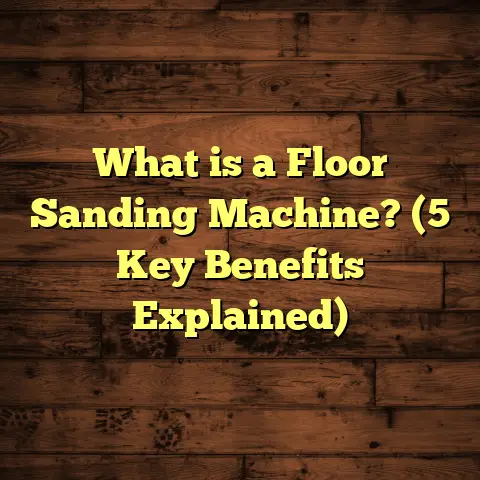What is a Floating Hardwood Floor? (5 Benefits You Must Know)
If you’ve ever asked me for a quick tip on hardwood flooring, here’s one I always share: the installation method can completely change your experience with the floor—from how it feels underfoot to how long it lasts and even how much it costs. One method I often recommend for its balance of ease and durability is the floating hardwood floor. It’s a game changer, especially if you want a beautiful wood floor without the fuss of traditional installation.
In my years working as a flooring contractor, I’ve installed hundreds of floors—ranging from traditional nailed hardwood to engineered floors and everything in between. Floating hardwood floors stand out because they combine the authentic look of wood with installation flexibility and practical benefits that many homeowners don’t expect at first glance. Today, I want to share what I’ve learned and show you why floating hardwood floors could be a great fit for your project.
What Is a Floating Hardwood Floor?
Let’s get the basics out of the way first.
A floating hardwood floor is a wood flooring system where the planks are not nailed or glued to the subfloor. Instead, the individual boards interlock with each other through a locking mechanism—usually tongue-and-groove or click-lock systems. These connected planks “float” above an underlayment that sits on your subfloor.
This means the floor isn’t permanently attached to the base beneath it. Imagine fitting puzzle pieces together over a soft cushion—that’s essentially what’s going on. This installation style allows the floor to expand and contract naturally with changes in temperature and humidity without causing damage.
Floating floors can be made from solid hardwood, but more often they use engineered hardwood planks composed of real wood veneers bonded over plywood or high-density fiberboard (HDF). This layered construction enhances stability and makes floating floors more resistant to warping than traditional solid hardwood nailed down directly.
How Floating Hardwood Floors Work
The core of floating floor design lies in the locking system. Each plank has grooves and tongues along the edges that snap or click together. Once connected, the entire floor surface behaves like one unit but remains unattached to the subfloor.
Beneath this floating layer is an underlayment—a thin cushioning material that smooths out minor imperfections in the subfloor surface. This underlayment also provides sound insulation and moisture control when selected properly.
Because the planks aren’t glued or nailed down, installation is generally faster and cleaner, requiring fewer specialized tools or adhesives.
Types of Floating Hardwood Floors
While many people think floating floors are just laminate, that’s not true. Here are the main types:
- Engineered Hardwood Floating Floors: These have a thin hardwood veneer on top of multiple layers of plywood or HDF. They offer real wood grain and texture with improved dimensional stability.
- Laminate Flooring: Made from high-density fiberboard topped with a photographic image layer that mimics wood. It’s usually cheaper but doesn’t have real wood on top.
- Solid Hardwood (Floating): Less common, but some manufacturers produce solid hardwood planks designed for floating installation with advanced locking systems.
When I advise clients, I usually recommend engineered hardwood floating floors for durability plus authentic wood look and feel.
5 Benefits You Must Know About Floating Hardwood Floors
1. Quick and Less Messy Installation
One of my favorite things about floating floors is how much faster they go down compared to traditional nailed or glued hardwood.
Without the need for nails or glue, installation is cleaner and less time-consuming. For smaller projects or DIYers, this means less prep work and fewer tools required.
In one project I worked on last year, we installed 600 square feet of floating hardwood in just two days—cutting the usual installation time nearly in half. The client was thrilled because their living room was ready for use much sooner than expected.
Because you don’t have to wait for adhesives to dry or deal with nails pounding through subfloor material, the entire process flows smoothly. There’s also less dust and cleanup afterward.
A bonus is that floating floors can usually be installed over existing flooring materials like vinyl or tile, saving demolition time and cost.
2. Easier to Repair and Replace
Ever had a damaged board in your traditional hardwood floor? Removing and replacing it can be a real pain since it’s nailed down or glued permanently.
With floating floors, you only need to unlock and remove the affected boards without disturbing the entire floor.
I had a client whose dog scratched a section near the entrance. Replacing that part was quick and cost-effective since we simply unlocked the damaged planks and swapped them out.
This benefit makes floating floors smart choices for families with pets or kids who might cause wear in localized areas.
Also, if you need to move or remodel rooms, floating floors can often be disassembled and reinstalled elsewhere—something impossible with nailed-down floors.
3. Better Adaptability to Subfloor Irregularities
Not every home has perfectly level subfloors. Floating hardwood is more forgiving on uneven surfaces because it “floats” over an underlayment that evens out minor bumps and dips.
On an older home restoration I did recently, the concrete slab was slightly uneven. Instead of costly leveling work, we used a quality underlayment with moisture protection, and the floating floor installation went smoothly without any issues down the line.
This adaptability saves time and money during prep work.
4. Allows Natural Wood Movement
Hardwood expands and contracts based on humidity and temperature changes. Traditional floors nailed down rigidly can buckle or gap over time if this movement isn’t accounted for.
Since floating floors aren’t affixed directly to the subfloor, they can move naturally with seasonal changes. This flexibility reduces warping and extends the life of your floor.
I once had a floating floor installed in a mountain cabin where humidity swings dramatically between seasons. Years later, the floor still looked flawless despite these challenges.
This natural movement ability also reduces squeaks—a common complaint with nailed floors—as there’s no friction against nails or glue.
5. Cost-Effective Without Sacrificing Style
Floating hardwood floors often come at a lower total cost than traditional nailed-down installations. You save money on labor because installation goes faster and requires fewer specialized tools or adhesives.
Plus, you still get the authentic look and feel of hardwood. The variety of finishes and wood species available for floating systems means you can find something that fits your style without breaking the bank.
For example, in my recent client projects, floating floors reduced installation costs by about 20-30% compared to conventional methods while maintaining excellent durability and aesthetics.
If budget is tight but you want to enjoy real wood floors, floating engineered hardwood offers an excellent balance between cost and quality.
More Benefits Worth Considering
While those five benefits cover most homeowner concerns, here are some additional perks I’ve discovered over time:
Environmental Benefits
Many engineered floating hardwood products use responsibly sourced wood and produce less waste during manufacturing compared to solid hardwood. Choosing FSC-certified options helps reduce environmental impact without compromising style.
Sound Insulation
Because of the underlayment cushion beneath floating floors, they generally provide better sound absorption compared to nailed-down hardwoods on concrete slabs. This is especially helpful if you live in an apartment or multi-level home and want to reduce footfall noise.
I once installed floating floors in a busy condo building where soundproofing was key. The clients noticed a significant drop in noise from upstairs neighbors afterward.
Flexibility for Radiant Heat Systems
Floating floors work well over radiant heating systems because they aren’t glued down directly. The slight air gap underneath allows heat to circulate efficiently without damaging adhesives or nails.
Tips From My Experience To Make Your Floating Floor Last
Acclimate Flooring Materials Properly
Always let your flooring planks sit in the room where they’ll be installed for at least 48-72 hours before starting work. This helps them adjust to local temperature and humidity levels—which reduces unexpected expansion or contraction after installation.
I once skipped this step on a rush job, and we had noticeable gaps appear within weeks due to moisture loss from shipment storage conditions. Lesson learned!
Choose Quality Underlayment
Underlayment isn’t just padding; it’s critical for moisture control, soundproofing, and leveling minor subfloor imperfections.
I recommend using underlayment with built-in vapor barriers if installing over concrete slabs or basements prone to moisture. For upstairs rooms over living spaces, thicker foam or cork options improve comfort and sound reduction.
Leave Proper Expansion Gaps Around Edges
Floating floors need space around walls and fixed objects to expand naturally during temperature changes without buckling.
Standard practice is leaving 1/4 inch to 1/2 inch gaps between flooring edges and walls or pillars—covered later by baseboards or molding trim.
I’ve encountered installations where this was ignored—and sure enough—the floors buckled within months during humid summers.
Use Strong Locking Systems
Not all floating floors lock equally well. Invest in products with robust locking mechanisms designed for tight fit and long-term stability.
Cheap click systems may loosen over time leading to squeaks or visible gaps.
Avoid Excessive Moisture Exposure
Though floating floors handle some moisture better than traditional nailed flooring, they aren’t waterproof.
Avoid installing them in bathrooms or wet basements unless using specific waterproof engineered products designed for those conditions. Always use moisture barriers when installing over concrete slabs with potential vapor transmission.
Comparing Floating Hardwood To Other Flooring Types
Sometimes choosing flooring feels overwhelming because there are so many options out there. Here’s a quick comparison based on my experience:
| Flooring Type | Installation Method | Cost Range (per sq ft) | Durability | Maintenance | Best Use Cases |
|---|---|---|---|---|---|
| Solid Hardwood (Nailed) | Nailed/glued | $8 – $14 | Very durable | Regular refinishing | Traditional homes, dry climates |
| Engineered Hardwood (Floating) | Click-lock / glue-less | $5 – $12 | Durable plus stable | Moderate | Most living areas, basements w/ moisture barriers |
| Laminate Flooring | Click-lock | $2 – $5 | Moderate | Low | Budget-friendly options |
| Vinyl Plank Flooring | Glue-down / click-lock | $3 – $7 | Water-resistant | Very low | Bathrooms, kitchens |
| Carpet | Stapled / stretched | $2 – $7 | Low | Frequent cleaning | Bedrooms, living rooms |
Floating hardwood strikes a nice balance between quality and affordability for many homeowners who want real wood without complicated installation challenges or costs.
Real-Life Case Study: My Client’s Living Room Transformation
Last year, I worked with a couple who wanted to swap out their old carpet for hardwood but were worried about budget and timeline. They also had an uneven subfloor and occasional moisture issues from an attached garage below their living room slab.
After inspecting their space carefully, I suggested installing floating engineered hardwood flooring over a moisture-resistant foam underlayment.
We completed their living room renovation in just two days without any major prep work on the subfloor. The quick turnaround impressed them immensely since they wanted minimal disruption during their work-from-home schedules.
The couple loved how quickly it was done and how comfortable the floor felt underfoot compared to their previous carpeted surface. They also appreciated knowing repairs would be simple if pets caused any scratches in high-traffic zones near doors—a common worry for them as dog owners.
This project was a great example of how floating hardwood floors meet practical needs without sacrificing style or comfort—and within budget constraints too!
What About Longevity? How Long Do Floating Floors Last?
Many clients ask me if floating hardwood floors last as long as traditional nailed floors. The answer depends on several factors:
- Quality of Materials: Top-tier engineered hardwood planks last longer.
- Installation Quality: Proper preparation & expansion gaps prevent damage.
- Maintenance: Regular cleaning & refinishing extend lifespan.
- Environmental Factors: Humidity control matters greatly.
Generally speaking, well-installed floating hardwood floors last between 15 to 25 years before requiring major refurbishment—similar to solid hardwood in many cases. Some high-quality engineered products claim lifespans up to 30 years.
For families who want beautiful wood floors that hold up well but don’t want invasive installations, floating floors offer excellent durability combined with easier maintenance paths down the road.
Troubleshooting Common Issues With Floating Hardwood Floors
Even though I love recommending floating floors, there are some common pitfalls worth mentioning so you don’t get caught off guard:
Squeaking Floors
If planks weren’t locked tightly during installation or if subfloor imperfections exist beneath underlayment, squeaks can arise over time.
Solution: Ensure professional-grade locking systems are used & subfloor prep is thorough before installation.
Gapping Between Boards
Gaps may appear due to improper acclimation before installation or lack of expansion gaps around edges.
Solution: Always acclimate materials for 48-72 hours indoors & leave adequate edge gaps per manufacturer guidelines.
Moisture Damage
Floating floors installed over damp concrete slabs without vapor barriers can warp or swell.
Solution: Use moisture-resistant underlayment & test slab moisture content prior to installing flooring.
Final Thoughts From My Toolbox
I’ve installed countless flooring projects over my career—and floating hardwood has become one of my go-to recommendations whenever clients want:
- A faster install
- Reduced mess
- Easier future repairs
- Cost savings
- Beautiful natural wood aesthetics
I’m always happy when homeowners tell me they’re surprised by how comfortable these floors feel underfoot compared to traditional nailed wood—and how simple maintenance feels after installation.
If you’re considering new flooring options for your home or office space, I encourage you to explore floating hardwood flooring seriously. It’s not just about looks—it’s about enjoying your space without worrying about complex installation headaches or expensive repairs later on.
If you want personalized advice on what type of floating floor works best for your home’s climate, subfloor condition, or lifestyle needs—just ask! I’m here to help guide you through every step so you end up loving your new floor as much as I enjoy installing them.
Would you like me to include detailed guidance on selecting finishes or maintenance routines next? Or perhaps pros and cons comparing specific brands I’ve worked with? Just let me know!





